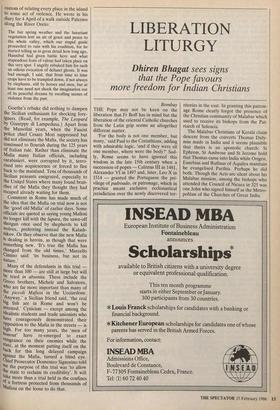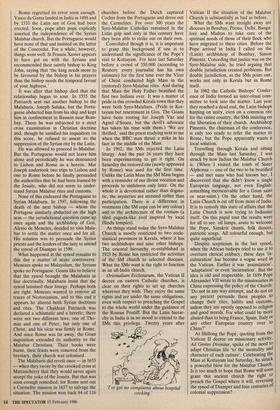LIBERATION LITURGY
Dhiren Bhagat sees signs
that the Pope favours more freedom for Indian Christians
Bombay THE Pope may not be keen on the liberation that Fr Boff has in mind but the liberation of the oriental Catholic churches from the Latin grip seems an altogether different matter.
'For the body is not one member, but many,' said Paul to the Corinthians, adding with admirable logic, 'and if they were all one member, where were the body?' Sad- ly, Rome seems to have ignored this wisdom in the late 15th century when a succession of popes — Calixtus III in 1481, Alexander VI in 1497 and, later, Leo X in 1514 — granted the Portuguese the pri- vilege of padroado, or patronage, which in practice meant exclusive ecclesiastical urisdiction over the newly discovered ter-
ritories in the east. In granting this patron- age Rome clearly forgot the presence of the Christian community of Malabar which used to receive its bishops from the Pat- riarch of Seleucia.
The Malabar Christians of Kerala claim descent from the converts Thomas Didy- mus made in India and it seems plausible that theirs is an apostolic church: St Ephrem, St Ambrose and St Jerome hold that Thomas came into India while Origen, Eusebius and Rufinus of Aquilea maintain he evangelised Parthia. Perhaps he did both. Though the Acts are silent about his Malabar mission, among the bishops who attended the Council of Nicaea in 325 was one John who signed himself as the Metro- politan of the Churches of Great India. Rome regretted its error soon enough. Vasco da Gama landed in India in 1498 and by 1533 the Latin see of Goa had been erected. Soon, pope after pope explicitly asserted the independence of the Syrian Malabar church. But the Portuguese would have none of that and insisted on the letter of the Concordat. For a while, however, things went well. St Francis Xavier appears to have got on with the Syrians and recommended their saintly bishop to King John, saying that 'the king needs more to be favoured by the bishop in his prayers than the bishop needs the temporal favour of your highness.'
It was after that bishop died that the relationship began to sour. In 1555 the Patriarch sent out another bishop to the Malabaris, Joseph Sulaka, but the Portu- guese abducted him from his ship and kept him in confinement in Bassein near Bom- bay. There he was subjected to a strict cross examination in Christian doctrine and, though he satisfied his inquisitors on this score, he refused to assent to the suppression of the Syrian rite by the Latin.
He was allowed to proceed to Malabar. But the Portuguese would not leave him alone and periodically he was denounced to Lisbon and Rome as a heretic. Mar Joseph undertook two trips to Lisbon and one to Rome before he finally persuaded the authorities that he had been framed by the Jesuits, who did not seem to under- stand Syrian Malabar rites and customs.
None of this endeared the Portuguese to Syrian Malabaris. In 1597, following the death of the next bishop — whom the Portugese similarly abducted on the high seas — the jurisdictional question came up once again and the archbishop of Goa, Alexio de Menezes, decided to visit Mala- bar to settle the matter once and for all. His solution was to persuade the Syrian priests and the leaders of the laity to attend the synod of Diamper in 1599.
What happened at the synod remains to this day a matter of acute controversy. Menezes spoke no Malayalam, the Syrians spoke no Portuguese. Goans like to believe that the synod brought the Malabaris in line doctrinally. Malabaris insist that the synod latinised their liturgy. Perhaps both are right. Menezes wanted to remove all traces of Nestorianism, and to this end it appears he altered both Syrian doctrines and rites. The Chaldean Patriarch was declared a schismatic and a heretic; there were not two different laws, one of Tho- mas and one of Peter, but only one of Christ, and his vicar was firmly in Rome. And since Rome was far away, the Goan inquisition extended its authority to the Malabar Christians. Their books were burnt, their feasts were removed from the breviary, their church was colonised.
The Malabaris did revolt once — in 1653 — when they swore by the crooked cross at Mattancherry that they would never again accept the yoke of the Jesuits. But that was soon enough remedied, for Rome sent out a Carmelite mission in 1657 to salvage the situation. The mission won back 84 of 116 churches before the Dutch captured Cochin from the Portuguese and drove out the Carmelites. For over 300 years the Syro-Malabar Catholics remained in the Latin grip and only in this century have they been able to strike out on their own.
Convoluted though it is, it is important to grasp this background if one is to understand the significance of the Pope's visit to Kottayam. For here last Saturday before a crowd of 350,000 (according to Reuters: every journalist has his own estimate) for the first time ever the Vicar of Christ conducted high Mass in the (restored) Syro-Malabar rites. And during that Mass the Holy Father beatified the first two Indians ever. It was a matter of pride in this crowded Kerala town that they were both Syro-Malabars. (Pride in Kot- tayam but resentment in Goa. The Goans have been rooting for Joseph Vaz and Agnel d'Souza, but the devil's advocate has taken his time with them.) 'We are thrilled,' said the priest studying next to me when the BBC man thrust a mike in his face in the middle of the Mass.
In 1962, the SMs rejected the Latin liturgy. And the past 24 years they have been experimenting to get it right. On Saturday the restored rite (newly approved by Rome) was used for the first time. Unlike the Latin Mass the SM Mass begins with a reminder of our divine vocation and proceeds to sinfulness only later. On the whole it is devotional rather than dogma- tic, the mysteries are stressed rather than participation. There is a difference in vestments (the SM cope can be any colour) and in the architecture of the rostium (a tiled pagoda-like roof inspired by local Hindu temples).
As things stand today the Syro-Malabar Church is mostly restricted to two eccle- siastical provinces in Kerala, where it has two archbishops and nine other bishops. The oriental hierarchy re-established in 1923 by Rome has restricted the activities of the SM church to selected dioceses. What the SMs want is the right to function as an all-India church.
Orientalium Ecclesiarum, the Vatican II decree on eastern Catholic churches, is clear on their rights to set up churches wherever they wish. They enjoy the same rights and are under the same obligations, even with respect to preaching the Gospel to the whole world under the guidance of the Roman Pontiff. But the Latin hierar- chy in India is in no mood to extend to the SMs this privilege. Twenty years after 'I've got no complaints about hospital cooking.' Vatican II the situation of the Malabar Church is substantially as bad as before.
What the SMs want straight away are dioceses in Bombay, Poona, Delhi, Banga- lore and Madras to take care of the spiritual needs of those of their flock who have migrated to these cities. Before the Pope arrived in India I called on the (Latin) archbishop of Bombay, Simon Pimenta. Conceding that justice was on the Syro-Malabar side, he tried arguing that double jurisdiction created problems. But double jurisdiction, as the SMs point out, works not only in Kerala but in Rome itself.
In 1982 the Catholic Bishops' Confer- ence of India formed an inter-ritual com- mittee to look into the matter. Last year they reached a dead end, the Latin bishops harping on unity, even on a common rite for the entire country, the SMs insisting on the liberation of their church. Archbishop Pimenta, the chairman of the conference, is only too ready to refer the matter to Rome, but the Pope apparently wants a local solution.
Travelling through Kerala and sitting through the Mass last Saturday, I was struck by how Indian the Malabar Church is. (When I visited the tomb of Sister Alphonsa — one of the two to be beatified — and met nuns who had known her, I discovered that she didn't know a single European language, not even English: something inconceivable for a Goan saint or near-saint.) On the other hand, the Latin Church is cut off from most of India. It is to remedy this state of affairs that the Latin Church is now trying to Indianise itself. On this papal tour the results were for all to see: oil lamps, aratis to welcome the Pope, Sanskrit chants, folk dances, patriotic songs. All colourful enough, but quite superficial.
Despite scepticism in the last synod, when the African bishops tried to use it to overturn clerical celibacy, these days 'in- culturation' has become a vogue word in the Vatican. Earlier it was 'assimilation', 'adaptation' or even 'incarnation'. But the idea is old and respectable. In 1659 Pope Alexander VII wrote to the missionaries in China expressing the policy of the Church: 'Do not in any way attempt, and do not on any pretext persuade these peoples to change their rites, habits and customs, unless they are openly opposed to religion and good morals. For what could be more absurd than to bring France, Spain, Italy or any other European country over to China?'
At Shillong the Pope, quoting from the Vatican II decree on missionary activity, Ad Gentes Divinitas, spoke of the need to adapt Christian life `to the mentality and character of each culture'. Celebrating the Mass at Kottayam last Saturday, he struck a powerful blow for the Malabar Church. Is it too much to hope that Rome will soon grant this ancient church the right to preach the Gospel where it will, reversing the synod of Diamper and four centuries of colonial suppression?






































 Previous page
Previous page